Weeds grow on the ruins of Marawi city in southern Philippines exactly a year after Filipino Muslim militants laid siege in the city Wednesday, May 23, 2018. Philippine officials say hundreds of displaced residents remain in emergency shelters as the threat of militants and unexploded bombs lingers in the ruins of a southern city that was held by Islamic State group-aligned fighters for five months last year. The May 23 siege that troops crushed in October, killed more than 1,100 mostly militants, sparked President Rodrigo Duterte's most serious crisis and reinforced Asia's fears that the Islamic State group is gaining a foothold in the region. (AP Photo)
The Associated Press
MARAWI, Philippines (AP) - Thousands of displaced remain in emergency shelters and the threat of Islamic extremists and unexploded bombs lingers in the rubble of a southern Philippine city, where survivors on Wednesday remembered a disastrous five-month siege by Islamic State group-aligned fighters that began a year ago.
The Rev. Teresito Soganub, who survived 117 days of captivity by the extremists in Marawi city, said that aside from the devastation, it would take years for him and other civilians to overcome the horror of having lived through airstrikes and gunbattles that threatened them day and night.
"I'm still very, very far from a full recovery," Soganub said by telephone. "If it takes long to rebuild and reconstruct, it's more difficult to deal with this psychological and psychiatric trauma."
The government is finalizing a plan to rebuild the most devastated commercial and residential districts, where the carcasses of pockmarked homes, buildings and mosques stand eerily and gathering weeds in an urban wasteland guarded by troops.
The city's journey back to normalcy may take years at a huge cost, said officials, some of whom have warned that if the rehabilitation falters, the restiveness it would generate could be exploited by Muslim militants.
"There were lots of bullets, a lot of cannon fire and airstrikes that targeted us because we were with the IS group that was being pounded by troops," Soganub said from his southern home province, where he held Mass with family and friends. "Each day of the 117 days, 24 hours, we were facing death every time and our lives depended on the temperament of our hostage takers."
Residents, officials and military officers released dozens of white balloons and doves into the blue sky from a government complex in lakeside Marawi and prayed for peace and recovery.
The May 23 siege that was crushed in October killed more than 1,100 mostly militants, left the mosque-studded city's heartland in rubbles, prompted President Rodrigo Duterte to place the southern third of the country under martial law and reinforced fears that the Islamic State group was gaining a foothold in the Asian region. The months of intense fighting forced hundreds of thousands of residents of Marawi and outlying towns to flee for their lives.
While many have returned home after the attack was quelled, thousands more whose houses were destroyed in the main battle area that remains off-limits to civilians are still living in evacuation centers and temporary shelters, officials said. At least 50 people are still listed as missing and many human remains have not yet been identified and have been buried in numbered graves.
A regional official, Zia Alonto Adiong, said it was crucial to keep the public informed.
"One day in an evacuation center is already too long for someone who has lost everything," Adiong said. "I think the frustration comes from the fear of expulsion, fear of not knowing what's going to happen."
Presidential adviser Jesus Dureza called for patience after some disgruntled Marawi residents held a noisy protest.
"We are working, government is doing its best to restore as much as possible what was destroyed and I think we are on the road," Dureza said. "But we'd like to call on all those who have gone through suffering to please be patient. There is no magic formula here. There is no reconstruction that will happen overnight. There will be a lot of challenges. Not everybody will agree, there will be contrary voices and feelings."

Weeds grow in the ruins of Marawi city in southern Philippines exactly a year after Filipino Muslim militants laid siege in the city Wednesday, May 23, 2018. Philippine officials say hundreds of displaced residents remain in emergency shelters as the threat of militants and unexploded bombs lingers in the ruins of a southern city that was held by Islamic State group-aligned fighters for five months last year. The May 23 siege that troops crushed in October, killed more than 1,100 mostly militants, sparked President Rodrigo Duterte's most serious crisis and reinforced Asia's fears that the Islamic State group is gaining a foothold in the region. (AP Photo)
The Associated Press
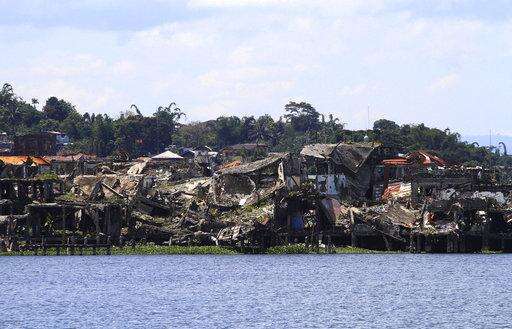
Weeds grow in the ruins of Marawi city in southern Philippines exactly a year after Filipino Muslim militants laid siege in the city Wednesday, May 23, 2018. Philippine officials say hundreds of displaced residents remain in emergency shelters as the threat of militants and unexploded bombs lingers in the ruins of a southern city that was held by Islamic State group-aligned fighters for five months last year. The May 23 siege that troops crushed in October, killed more than 1,100 mostly militants, sparked President Rodrigo Duterte's most serious crisis and reinforced Asia's fears that the Islamic State group is gaining a foothold in the region. (AP Photo)
The Associated Press

The bullet-riddled house where killed Abu Sayyaf leader Isnilon Hapilon allegedly used as his group's hideout in laying siege of Marawi city is shown exactly a year ago Wednesday, May 23, 2018 in southern Philippines. Philippine officials say hundreds of displaced residents remain in emergency shelters as the threat of militants and unexploded bombs lingers in the ruins of a southern city that was held by Islamic State group-aligned fighters for five months last year. The May 23 siege that troops crushed in October, killed more than 1,100 mostly militants, sparked President Rodrigo Duterte's most serious crisis and reinforced Asia's fears that the Islamic State group is gaining a foothold in the region. (AP Photo)
The Associated Press

Protesters strike a painting depicting President Rodrigo Duterte as they mark the anniversary of the siege by Islamic State group-aligned militants of Marawi city in southern Philippines exactly a year ago Wednesday, May 23, 2018 in Manila, Philippines. The May 23 siege that troops crushed in October, killed more than 1,100 mostly militants, left the mosque-studded city's heartland in rubbles, gave President Rodrigo Duterte's his most serious crisis and reinforced Asian fears that the Islamic State group has gained a foothold in the region. (AP Photo/Bullit Marquez)
The Associated Press

Protesters burn a painting depicting President Rodrigo Duterte as they mark the anniversary of the siege by Islamic State group-aligned militants of Marawi city in southern Philippines exactly a year ago Wednesday, May 23, 2018 in Manila, Philippines. The May 23 siege that troops crushed in October, killed more than 1,100 mostly militants, left the mosque-studded city's heartland in rubbles, gave President Rodrigo Duterte's his most serious crisis and reinforced Asian fears that the Islamic State group has gained a foothold in the region. (AP Photo/Bullit Marquez)
The Associated Press
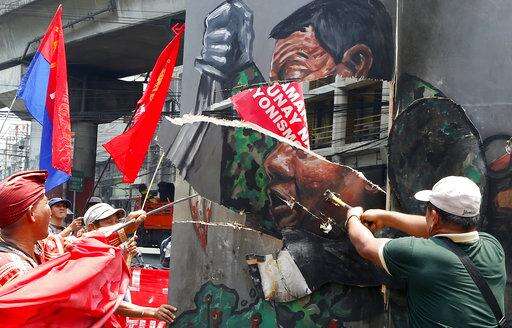
Protesters destroy a painting depicting President Rodrigo Duterte as they mark the anniversary of the siege by Islamic State group-aligned militants of Marawi city in southern Philippines exactly a year ago Wednesday, May 23, 2018 in Manila, Philippines. The May 23 siege that troops crushed in October, killed more than 1,100 mostly militants, left the mosque-studded city's heartland in rubbles, gave President Rodrigo Duterte's his most serious crisis and reinforced Asian fears that the Islamic State group has gained a foothold in the region. (AP Photo/Bullit Marquez)
The Associated Press
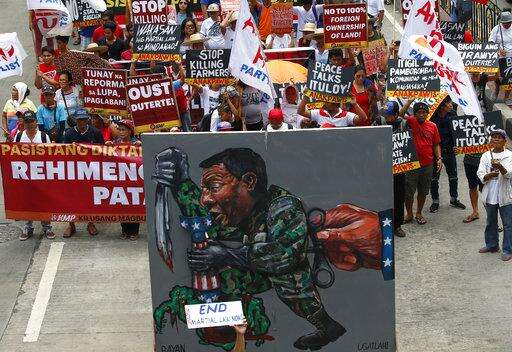
Protesters march towards the Presidential Palace with a huge mural depicting President Rodrigo Duterteas they mark the anniversary of the siege by Islamic State group-aligned militants of Marawi city in southern Philippines exactly a year ago Wednesday, May 23, 2018. The May 23 siege that troops crushed in October killed more than 1,100 mostly militants, left the mosque-studded city's heartland in rubbles, gave President Rodrigo Duterte's his most serious crisis and reinforced Asian fears that the Islamic State group has gained a foothold in the region. (AP Photo/Bullit Marquez)
The Associated Press
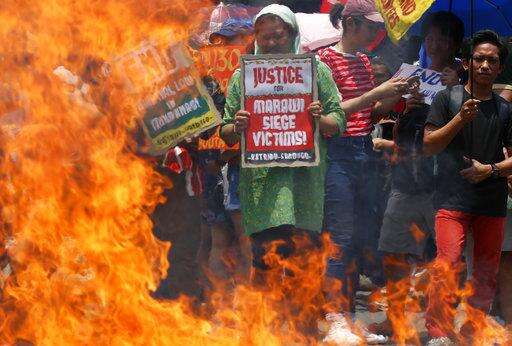
Protesters light placards on fire to mark the anniversary of the siege by Islamic State group-aligned militants of Marawi city in southern Philippines exactly a year ago Wednesday, May 23, 2018. The May 23 siege that troops crushed in October, killed more than 1,100 mostly militants, left the mosque-studded city's heartland in rubbles, gave President Rodrigo Duterte's his most serious crisis and reinforced Asian fears that the Islamic State group has gained a foothold in the region. (AP Photo/Bullit Marquez)
The Associated Press
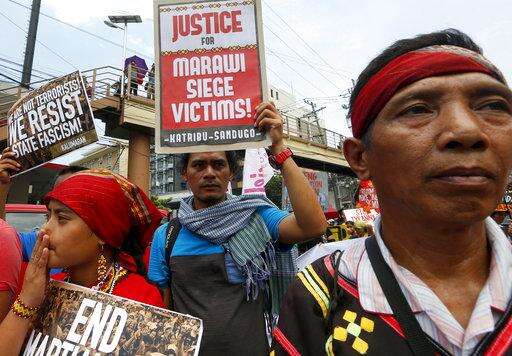
Protesters rally near the Presidential Palace to mark the anniversary of the siege by Islamic State group-aligned militants of Marawi city in southern Philippines exactly a year ago Wednesday, May 23, 2018. The May 23 siege that troops crushed in October, killed more than 1,100 mostly militants, left the mosque-studded city's heartland in rubbles, gave President Rodrigo Duterte's his most serious crisis and reinforced Asian fears that the Islamic State group has gained a foothold in the region. (AP Photo/Bullit Marquez)
The Associated Press
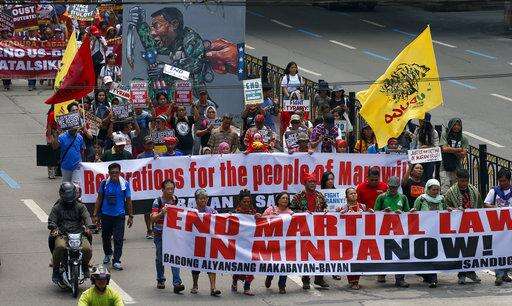
Protesters march towards the Presidential Palace to mark the anniversary of the siege by Islamic State group-aligned militants of Marawi city in southern Philippines, a year ago, Wednesday, May 23, 2018. The May 23 siege that troops crushed in October killed more than 1,100 mostly militants, left the mosque-studded city's heartland in rubbles, gave President Rodrigo Duterte's his most serious crisis and reinforced Asian fears that the Islamic State group has gained a foothold in the region. (AP Photo/Bullit Marquez)
The Associated Press